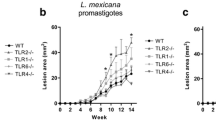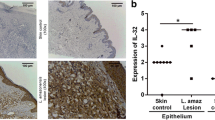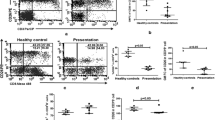Abstract
Leishmania amazonensis is the etiological agent of diffuse cutaneous leishmaniasis. The immunopathology of leishmaniasis caused by L. amazonensis infection is dependent on the pathogenic role of effector CD4+ T cells. Purinergic signalling has been implicated in resistance to infection by different intracellular parasites. In this study, we evaluated the role of the P2X7 receptor in modulating the immune response and susceptibility to infection by L. amazonensis. We found that P2X7-deficient mice are more susceptible to L. amazonensis infection than wild-type (WT) mice. P2X7 deletion resulted in increased lesion size and parasite load. Our histological analysis showed an increase in cell infiltration in infected footpads of P2X7-deficient mice. Analysis of the cytokine profile in footpad homogenates showed increased levels of IFN-γ and decreased TGF-β production in P2X7-deficient mice, suggesting an exaggerated pro-inflammatory response. In addition, we observed that CD4+ and CD8+ T cells from infected P2X7-deficient mice exhibit a higher proliferative capacity than infected WT mice. These data suggest that P2X7 receptor plays a key role in parasite control by regulating T effector cells and inflammation during L. amazonensis infection.




Similar content being viewed by others
Abbreviations
- KO:
-
Knockout
- DPI:
-
Days postinfection
- ROS:
-
Reactive oxygen species
- NO:
-
Nitric oxide
- LTB4:
-
Leukotriene B4
- FBS:
-
Heat-inactivated foetal bovine serum
- CEUA:
-
Commission for Ethical Use of Research Animals
- TCA:
-
Trichloroacetic acid
- GFI-1:
-
Growth factor-independent 1 transcription repressor
- M199:
-
199 medium
- DMEM:
-
Dulbecco’s modified Eagle’s medium
References
Alvar J, Velez ID, Bern C, Herrero M, Desjeux P, Cano J, Jannin J, Den BM (2012) Leishmaniasis worldwide and global estimates of its incidence. PLoS One 7:e35671
Showler AJ, Boggild AK (2015) Cutaneous leishmaniasis in travellers: a focus on epidemiology and treatment in 2015. Curr Infect Dis Rep 17:489–0489
Mukbel RM, Patten C Jr, Gibson K, Ghosh M, Petersen C, Jones DE (2007) Macrophage killing of Leishmania amazonensis amastigotes requires both nitric oxide and superoxide. AmJTrop Med Hyg 76:669–675
Henard CA, Carlsen ED, Hay C, Kima PE, Soong L (2014) Leishmania amazonensis amastigotes highly express a tryparedoxin peroxidase isoform that increases parasite resistance to macrophage antimicrobial defenses and fosters parasite virulence. PLoS Negl Trop Dis 8:e3000
Burnstock G (2007) Purine and pyrimidine receptors. Cell Mol Life Sci 64:1471–1483
Burnstock G, Boeynaems JM (2014) Purinergic signalling and immune cells. Purinergic Signal 10:529–564
Santos AA Jr, Rodrigues-Junior V, Zanin RF, Borges TJ, Bonorino C, Coutinho-Silva R, Takyia CM, Santos DS, Campos MM, Morrone FB (2013) Implication of purinergic P2X7 receptor in M. Tuberculosis infection and host interaction mechanisms: a mouse model study. Immunobiology 218:1104–1112
Kusner DJ, Adams J (2000) ATP-induced killing of virulent mycobacterium tuberculosis within human macrophages requires phospholipase D. J Immunol 164:379–388
Correa G, Marques da SC, de Abreu Moreira-Souza AC, Vommaro RC, Coutinho-Silva R (2010) Activation of the P2X(7) receptor triggers the elimination of toxoplasma gondii tachyzoites from infected macrophages. Microbes Infect 12:497–504
Morandini AC, Savio LE, Coutinho-Silva R (2014) The role of P2X7 receptor in infectious inflammatory diseases and the influence of ectonucleotidases. Biomed J 37:169–177
Miller CM, Zakrzewski AM, Robinson DP, Fuller SJ, Walker RA, Ikin RJ, Bao SJ, Grigg ME, Wiley JS, Smith NC (2015) Lack of a functioning P2X7 receptor leads to increased susceptibility to Toxoplasmic ileitis. PLoS One 10:e0129048
Liu Y, Xiao Y, Li Z (2011) P2X7 receptor positively regulates MyD88-dependent NF-kappaB activation. Cytokine 55:229–236
Coutinho-Silva R, Ojcius DM (2012) Role of extracellular nucleotides in the immune response against intracellular bacteria and protozoan parasites. Microbes Infect 14:1271–1277
Biswas D, Qureshi OS, Lee WY, Croudace JE, Mura M, Lammas DA (2008) ATP-induced autophagy is associated with rapid killing of intracellular mycobacteria within human monocytes/macrophages. BMC Immunol 9:35. doi:10.1186/1471-2172-9-35.:35-39 35-39
Chaves SP, Torres-Santos EC, Marques C, Figliuolo VR, Persechini PM, Coutinho-Silva R, Rossi-Bergmann B (2009) Modulation of P2X(7) purinergic receptor in macrophages by Leishmania amazonensis and its role in parasite elimination. Microbes Infect 11:842–849
Chaves MM, Marques-da-Silva C, Monteiro AP, Canetti C, Coutinho-Silva R (2014) Leukotriene B4 modulates P2X7 receptor-mediated Leishmania amazonensis elimination in murine macrophages. J Immunol 192:4765–4773
Ji J, Sun J, Qi H, Soong L (2002) Analysis of T helper cell responses during infection with Leishmania amazonensis. AmJTrop Med Hyg 66:338–345
Soong L, Chang CH, Sun J, Longley BJ Jr, Ruddle NH, Flavell RA, McMahon-Pratt D (1997) Role of CD4+ T cells in pathogenesis associated with Leishmania amazonensis infection. J Immunol 158:5374–5383
Ji J, Masterson J, Sun J, Soong L (2005) CD4 + CD25+ regulatory T cells restrain pathogenic responses during Leishmania amazonensis infection. J Immunol 174:7147–7153
Lonardoni MV, Russo M, Jancar S (2000) Essential role of platelet-activating factor in control of Leishmania (Leishmania) amazonensis infection. Infect Immun 68:6355–6361
Felizardo TC, Gaspar-Elsas MI, Lima GM, Abrahamsohn IA (2012) Lack of signaling by IL-4 or by IL-4/IL-13 has more attenuating effects on Leishmania amazonensis dorsal skin--than on footpad-infected mice. Exp Parasitol 130:48–57
Titus RG, Marchand M, Boon T, Louis JA (1985) A limiting dilution assay for quantifying Leishmania major in tissues of infected mice. Parasite Immunol 7:545–555
de Matos Guedes HL, da Silva Costa BL, Chaves SP, de Oliveira Gomes DC, Nosanchuk JD, De Simone SG, Rossi-Bergmann B (2014) Intranasal vaccination with extracellular serine proteases of Leishmania amazonensis confers protective immunity to BALB/c mice against infection. Parasit Vectors 19(7):448. doi:10.1186/1756-3305-7-448 448-7
Miller CM, Boulter NR, Fuller SJ, Zakrzewski AM, Lees MP, Saunders BM, Wiley JS, Smith NC (2011) The role of the P2X(7) receptor in infectious diseases. PLoS Pathog 7:e1002212
Coutinho-Silva R, Correa G, Sater AA, Ojcius DM (2009) The P2X(7) receptor and intracellular pathogens: a continuing struggle. Purinergic Signal 5:197–204
Miller CM, Zakrzewski AM, Ikin RJ, Boulter NR, Katrib M, Lees MP, Fuller SJ, Wiley JS, Smith NC (2011) Dysregulation of the inflammatory response to the parasite, toxoplasma gondii, in P2X7 receptor-deficient mice. Int J Parasitol 41:301–308
Amaral EP, Ribeiro SC, Lanes VR, Almeida FM, de Andrade MR, Bomfim CC, Salles EM, Bortoluci KR, Coutinho-Silva R, Hirata MH, Alvarez JM, Lasunskaia EB, D’Imperio-Lima MR (2014) Pulmonary infection with hypervirulent mycobacteria reveals a crucial role for the P2X7 receptor in aggressive forms of tuberculosis. PLoS Pathog 10:e1004188
Adriouch S, Dox C, Welge V, Seman M, Koch-Nolte F, Haag F (2002) Cutting edge: a natural P451L mutation in the cytoplasmic domain impairs the function of the mouse P2X7 receptor. J Immunol 169:4108–4112
Neves AR, Castelo-Branco MT, Figliuolo VR, Bernardazzi C, Buongusto F, Yoshimoto A, Nanini HF, Coutinho CM, Carneiro AJ, Coutinho-Silva R, de Souza HS (2014) Overexpression of ATP-activated P2X7 receptors in the intestinal mucosa is implicated in the pathogenesis of Crohn’s disease. Inflamm Bowel Dis 20:444–457
Hofman P, Cherfils-Vicini J, Bazin M, Ilie M, Juhel T, Hebuterne X, Gilson E, Schmid-Alliana A, Boyer O, Adriouch S, Vouret-Craviari V (2015) Genetic and pharmacological inactivation of the purinergic P2RX7 receptor dampens inflammation but increases tumor incidence in a mouse model of colitis-associated cancer. Cancer Res 75:835–845
Rissiek B, Haag F, Boyer O, Koch-Nolte F, Adriouch S (2015) P2X7 on mouse T cells: one channel, many functions. Front Immunol 19(6):204. doi:10.3389/fimmu.2015.00204 eCollection;%2015.:204
Chen L, Brosnan CF (2006) Exacerbation of experimental autoimmune encephalomyelitis in P2X7R−/− mice: evidence for loss of apoptotic activity in lymphocytes. J Immunol 176:3115–3126
Heiss K, Janner N, Mahnss B, Schumacher V, Koch-Nolte F, Haag F, Mittrucker HW (2008) High sensitivity of intestinal CD8+ T cells to nucleotides indicates P2X7 as a regulator for intestinal T cell responses. J Immunol 181:3861–3869
Koutsoni O, Barhoumi M, Guizani I, Dotsika E (2014) Leishmania eukaryotic initiation factor (LeIF) inhibits parasite growth in murine macrophages. PLoS One 9:e97319
Gendron FP, Chalimoniuk M, Strosznajder J, Shen S, Gonzalez FA, Weisman GA, Sun GY (2003) P2X7 nucleotide receptor activation enhances IFN gamma-induced type II nitric oxide synthase activity in BV-2 microglial cells. J Neurochem 87:344–352
Buxbaum LU (2015) Interleukin-10 from T cells, but not macrophages and granulocytes, is required for chronic disease in Leishmania mexicana infection. Infect Immun 83:1366–1371
Schwarz T, Remer KA, Nahrendorf W, Masic A, Siewe L, Muller W, Roers A, Moll H (2013) T cell-derived IL-10 determines leishmaniasis disease outcome and is suppressed by a dendritic cell based vaccine. PLoS Pathog 9:e1003476
Bacellar O, Lessa H, Schriefer A, Machado P, Ribeiro de JA, Dutra WO, Gollob KJ, Carvalho EM (2002) Up-regulation of Th1-type responses in mucosal leishmaniasis patients. Infect Immun 70:6734–6740
Trinchieri G (2007) Interleukin-10 production by effector T cells: Th1 cells show self control. J Exp Med 19(204):239–243
Anderson CF, Oukka M, Kuchroo VJ, Sacks D (2007) CD4(+)CD25(−)Foxp3(−) Th1 cells are the source of IL-10-mediated immune suppression in chronic cutaneous leishmaniasis. J Exp Med 19(204):285–297
Jankovic D, Kullberg MC, Feng CG, Goldszmid RS, Collazo CM, Wilson M, Wynn TA, Kamanaka M, Flavell RA, Sher A (2007) Conventional T-bet(+)Foxp3(−) Th1 cells are the major source of host-protective regulatory IL-10 during intracellular protozoan infection. J Exp Med 19(204):273–283
Bogdan C, Nathan C (1993) Modulation of macrophage function by transforming growth factor beta, interleukin-4, and interleukin-10. Ann N Y Acad Sci 685:713–739 713-739
Espir TT, Figueira LP, Naiff MF, da Costa AG, Ramalho-Ortigao M, Malheiro A, Franco AM (2014) The role of inflammatory, anti-inflammatory, and regulatory cytokines in patients infected with cutaneous leishmaniasis in Amazonas state, Brazil. J Immunol Res 2014. doi:10.1155/2014/481750
Acknowledgements
This work was supported by funds from the Conselho Nacional de Desenvolvimento Cientifico e Tecnológico do Brasil (CNPq), Coordenação de Aperfeiçoamento de Pessoal de Nível Superior (CAPES), the Programa de Núcleos de Excelência (PRONEX), Fundação de Amparo à Pesquisa do Estado do Rio de Janeiro (FAPERJ), the Instituto Nacional de Ciência e Tecnologia para Pesquisa Translacional em Saúde e Ambiente na Região Amazônica (INPeTAm/UFRJ), and the Fundação de Amparo à Pesquisa do Estado de São Paulo (FAPESP).
Author information
Authors and Affiliations
Corresponding author
Ethics declarations
Conflict of interest
Vanessa Ribeiro Figliuolo declares that she has no conflict of interest.
Suzana Passos Chaves declares that she has no conflict of interest.
Luiz Eduardo Baggio Savio declares that he has no conflict of interest.
Maria Luiza Prates Thorstenberg declares that she has no conflict of interest.
Érika Machado Salles declares that she has no conflict of interest.
Christina Maeda Takiya declares that she has no conflict of interest.
Maria Regina D’Império-Lima declares that she has no conflict of interest.
Herbert Leonel de Matos Guedes declares that he has no conflict of interest.
Bartira Rossi-Bergmann declares that she has no conflict of interest.
Robson Coutinho-Silva declares that he has no conflict of interest.
Ethical approval
All animals received care according to institutional guidelines, and all procedures were according to EU guidelines (2010/63) after approval by the Animal Care Committee of the Federal University of Rio de Janeiro.
Additional information
Vanessa Ribeiro Figliuolo and Suzana Passos Chaves contributed equally
Rights and permissions
About this article
Cite this article
Figliuolo, V.R., Chaves, S.P., Savio, L.E.B. et al. The role of the P2X7 receptor in murine cutaneous leishmaniasis: aspects of inflammation and parasite control. Purinergic Signalling 13, 143–152 (2017). https://doi.org/10.1007/s11302-016-9544-1
Received:
Accepted:
Published:
Issue Date:
DOI: https://doi.org/10.1007/s11302-016-9544-1




